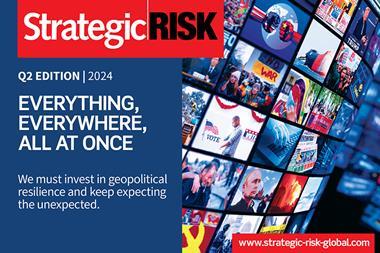EXPERT VIEW Riskonnect’s Claire Hopper has advice on how to build a culture where everyone incorporates risk considerations into everything they do – making sure they are always looking, listening and mitigating for potential problems.
In association with Riskonnect
Many organisations are putting risk management front and centre for all employees, not just those with ‘risk’ in their title.
That’s because they realise how important it is to be agile and to quickly identify emerging threats and take corrective actions before they can escalate.

Culture weaves risk management into the everyday routine of employees. With more eyes and ears on the lookout for risks, a company is much less likely to be blindsided – and that’s a significant competitive advantage.
Here are seven steps to make risk a part of every decision at your organisation:
This expert view is taken from our special report on risk culture. You can read the full digital report here or in the latest issue of the magazine.
1) Educate
Equip employees with knowledge. Explain the benefits of risk management, how to spot issues, how to assess potential impact, and how to mitigate threats. Show employees that reducing risk is in everyone’s best interests.
2) Communicate
Have a clear, well-defined process for reporting risks. Guidelines must be specific, direct and go beyond ‘if you see something, say something’. Create forms with prepopulated fields to make it easy to navigate the process and collect all necessary information while it’s still fresh.
3) Get top-level buy-in
If the senior leaders of an organisation are visibly making risk-conscious decisions, others will follow. In the chaos of a crisis, it might be tempting to cut a few ethical corners for the sake of speed, but leaders who refuse to compromise integrity set a great example for others.
4) Break down silos
Establish a risk committee that includes stakeholders from multiple departments. Centralise risk information, standardise data and show the relationships between threats. Establish a common risk language and facilitate productive conversations to identify and address vulnerabilities.
Case study - creating a risk-aware culture
A large food distribution organisation noticed an upward trend in the frequency and severity of workers’ compensation and liability claims.
Here’s how it reduced incidents by educating and financially motivating employees to recognise potential risks.
Numbers for key safety metrics – accidents per million miles (AMM) and recordable case rates (RCR) – were higher than its competitors’.
In addition to immediate concerns over employee well-being, the high volume of claims was straining financials.
Management wanted to instil a safety-oriented culture to reduce the risk of injuries and lower the number of claims. The goal was to reduce AMM and RCR by 20%.
The company wanted to emphasise that:
- Everyone can make a difference.
- All employees need to be aware of the risks.
- Reducing incidents and claim volume is in everyone’s best interest.
The company used scorecards to create a ranking showing how each operating unit performed across 17 risk and safety categories, including AMM, RCR, required training compliance and root-cause completion percentage.
This encouraged a cultural change in two ways: Overall scores were shared across the organisation, which motivated each unit to improve, and there was a clear financial incentive as bonuses were tied to achieving goals.
Now, locations eagerly await the quarterly ranking report, and improving safety scores is a point of pride. Employees understand the value of fixing a problem – and how their actions can make a difference.
5) Assign responsibility
Identify the individual who is most closely connected to each risk and hold that person accountable. When responsibilities are clear, there’s less of a chance something will fall through the cracks.
6) Establish incentives
Baking risk management expectations into performance plans gets people thinking about how they can correct issues. O er spot bonuses to employees who identify risks and come up with a solution. Tie annual bonuses to achieving risk-related goals.
7) Leverage technology
Technology can gather all risk-related data from claims, internal audit, safety and third parties into one location. This increases transparency and elevates the visibility of risk. Point values can be given to each KPI and totalled for an overall risk score, which business unit leaders can then use to review progress and suggest follow-up actions.
NOT BUILT IN A DAY
Positive risk culture protects the customer, brand and bottom line. When everyone from the CEO to new interns are aware of the risk inherent in every decision, potential issues can be addressed in advance.
Unexpected issues are less likely to occur, and when they do, the impact tends to be less severe. A great risk culture is not something that can be built in a single all-staff email or all-hands meeting.
It takes time to educate people, spark dialogue and instil a belief that everyone has the power to make a difference.
Claire Hopper is international sales engineer at Riskonnect.














